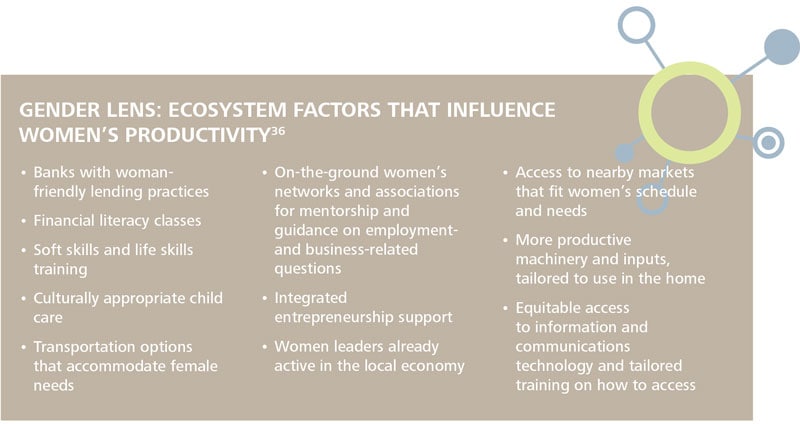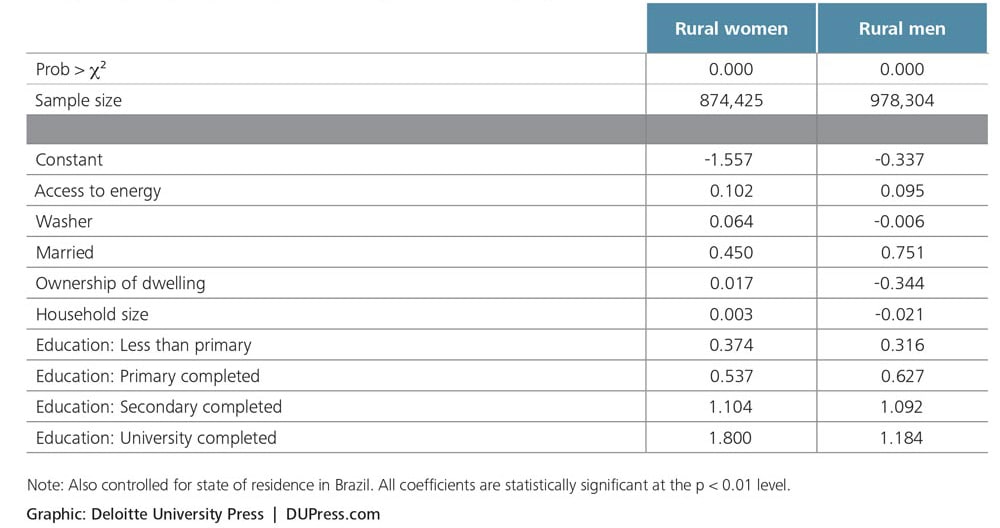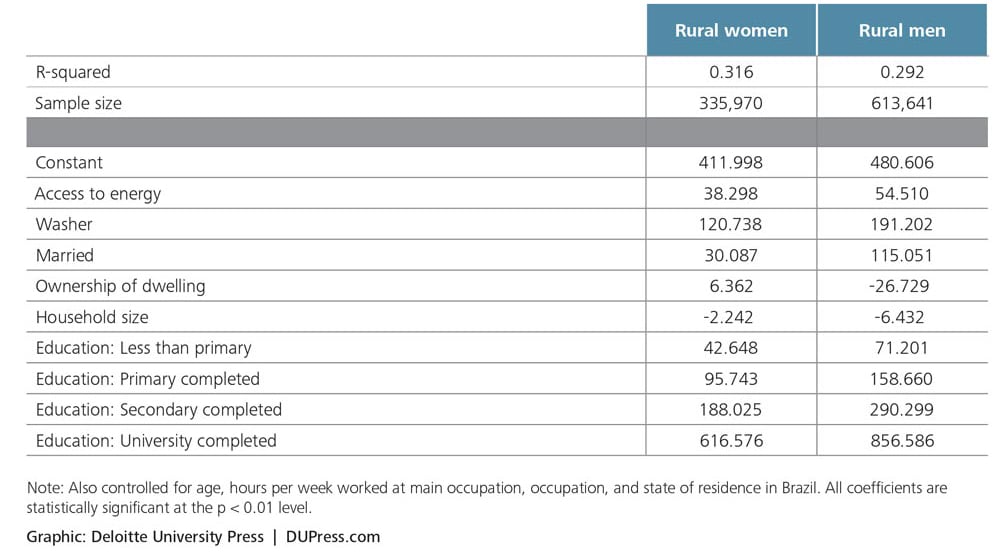Women, energy, and economic empowerment has been saved

Women, energy, and economic empowerment Applying a gender lens to amplify the impact of energy access
19 September 2014
- Kathleen O’Dell, Sophia Peters, Kate Wharton
With a “gender lens” approach to energy access programs, the millions of dollars flowing to energy access initiatives around the globe can have a greater impact on women’s empowerment.

Executive summary
There are two well-accepted narratives related to economic growth. First, vast gender inequalities remain throughout the world and are closely linked to poverty and instability. Second, access to modern energy enables economic advancement. Until now, however, exploration into the relationship between these two narratives has been limited. What is missing, it seems, is the linkage between energy access and women’s economic empowerment. Under what context does gender equality rise with access to electricity; what are the channels through which this change occurs; and how significant are the economic benefits to women? Can donor institutions and governments reap more meaningful results by targeting energy development programs that enhance benefits for women, and if so, how? In this report, we explore these questions. We believe that while there are many areas critically important for women’s development, energy access programs are an underexplored lever for women’s economic empowerment.
The untapped link between gender and energy
Gender has been examined many ways in international development programs, from maternal health to gender-based violence to the education of girls. Where these basic needs have been met, development programming has pivoted to focus on skills development, access to finance and credit, support for female entrepreneurs, and other efforts aimed at increasing economic engagement. Other programs tackle systemic gender issues such as land rights and property laws, political participation, and equal access laws. Noticeably less prevalent in this discussion, however, is the topic of access to energy and its impact on women and girls. In parallel, reliable, affordable energy is increasingly recognized by the international development community as an enabler of economic growth. The United Nations launched its Sustainable Energy for All (SE4A) initiative and declared 2014–2024 the Sustainable Energy for All Decade. Likewise, in 2013, President Barack Obama launched Power Africa, an initiative to double the number of people with access to power in sub-Saharan Africa, where two-thirds of the population is currently without access.1Similarly, in Asia, the Asian Development Bank launched the Energy for All Partnership, which aims to provide access to safe, affordable modern energy for an additional 100 million people in the region by 2015.2 There are two well-accepted narratives related to economic growth. First, vast gender inequalities remain throughout the world and are closely linked to poverty and instability. Second, access to modern energy enables economic advancement. Until now, however, exploration into the relationship between these two narratives has been limited. What is missing, it seems, is the linkage between energy access and women’s economic empowerment.
Energy is very important in women’s daily lives, especially for serving food for families, lighting for teaching their children at night, and energy for their small food industries. . . . Cooking and small business are the major challenges facing women around access to energy. . . . For the women in my country, a change that would allow them to be financially independent would have the most impact in their lives.3
—Dr. Nurzainah Ginting, Indonesia
This raises several questions. Under what context does gender equality rise with access to electricity; what are the channels through which this change occurs; and how significant are the economic benefits to women? Can donor institutions and governments reap more meaningful results by targeting energy development programs that enhance benefits for women, and if so, how? We believe that while there are many areas critically important for women’s development, energy access programs are an underexplored lever for women’s economic empowerment. The purpose of this report is to reach a common understanding of this linkage and to establish a framework that takes this into account. With such a framework, the millions of dollars flowing to energy access initiatives around the globe can have a greater impact on the women and communities they are intended to serve. To investigate this gender-energy nexus, we analyzed a combination of quantitative and qualitative data. Our quantitative analysis uses both global indicator databases and national census data to understand the complex relationship between electrification and economic opportunity. This data is supplemented by a series of interviews with women in the developing world that examines the impact of energy on their personal lives and the lives of women in their countries. We conclude by offering ideas to accelerate benefits to developing nations through a “gender lens” approach to energy access programs.
To have and to have not
On a macro level, we know that energy increases productivity and enables new industries to thrive, ultimately contributing to improved social and economic outcomes for individuals.4 According to the International Energy Agency (IEA), modern energy access at the household level is “a household having reliable and affordable access to clean cooking facilities, a first connection to electricity, and then an increasing level of electricity consumption over time to reach the regional average.”5 As this definition conveys, energy in rural developing country settings is often a continuum, potentially first being provided by small household items like a solar lantern, kerosene lamp, or improved cookstove, then possibly a small solar home system or diesel generator, and eventually provisioned through community-based minigrid options or possibly even connection to the national grid. Along this continuum, it is the outputs made accessible to end users by the provision of this energy—lighting, cooking, mobile phone charging, refrigeration, etc.—that are of interest to our investigation rather than the electricity inputs themselves.
The solar home systems allow [women] to have more income. . . My opinion is that they tend to have more confidence if they can earn more income—sometimes equal to their husbands— and with that comes power.6
—Salinee Tavaranan, Thailand
In exploring whether power translates to empowerment, we define modern energy access as reliable and affordable. We must also define meaningful economic empowerment. Often, participation in the labor force has been a proxy for economic empowerment. But in this case, we would then have to accept a wide range of outcomes as “success”—including extremely low-wage labor, poor working conditions, and participation in the informal economy. Instead, we use a much richer definition provided by the International Center for Research on Women: Economic empowerment is when a woman “has both the ability to succeed and advance economically and the power to make and act on economic decisions.”7 In this way, instead of just looking at female employment, we look at additional dimensions of employment that signify value and advancement, such as earned income, hours worked, class of work, job security, working conditions, and opportunity for advancement.8 We also look at the factors leading to empowerment around economic decision-making—namely skills and education—and at the overall relationship between poverty, gender inequality, and energy access.
Women, energy, and poverty: Global trends
Global data suggests that gender inequality (as measured by the Gender Inequality Index9) is strongly correlated with national poverty levels, as measured by the proportion of the population living under $1.25 a day (shown in figure 1).10
 Whether through causation or correlation, gender inequality and poverty are closely intertwined; tackling the former means mitigating the latter. Energy access programs that are coupled with meaningful income-generating activities can play a critical role on both fronts. Analysis of country-level data shows that the greater the proportion of a country’s population that has access to electricity, the greater its gender equality—regardless of the proportion of its population living under $1.25 a day.11 In looking at energy usage, men and women have different energy needs, and both benefit differently from increased access to electricity.12 For example, improved access to time-saving electric appliances has been significantly more transformative for women than men due to women’s role relative to household chores. We see this in studies examining the impact of household appliances on US women during the last century. Coen-Pirani et al. found that “diffusion of household appliances contributed to the increase in married women’s labor force participation rates during the 1960s.”13 Yet we also know that, while freeing up extra time for women is necessary to advance economic empowerment, it is not sufficient. Lewis shows that from 1930 to 1960 in the United States, “household electrification had no immediate impact on female employment, but is associated with increased school attendance, particularly among teenage daughters, and ultimately led to improvements in the labor market outcomes of subsequent cohorts of women.”14 This study highlights two important points: 1) critical indirect benefits from energy access can be delayed—and even cross-generational—in terms of economic outcomes for women; and 2) improved energy access should be part of a broader strategy that enables women to spend their extra time on economically empowering activities.
Whether through causation or correlation, gender inequality and poverty are closely intertwined; tackling the former means mitigating the latter. Energy access programs that are coupled with meaningful income-generating activities can play a critical role on both fronts. Analysis of country-level data shows that the greater the proportion of a country’s population that has access to electricity, the greater its gender equality—regardless of the proportion of its population living under $1.25 a day.11 In looking at energy usage, men and women have different energy needs, and both benefit differently from increased access to electricity.12 For example, improved access to time-saving electric appliances has been significantly more transformative for women than men due to women’s role relative to household chores. We see this in studies examining the impact of household appliances on US women during the last century. Coen-Pirani et al. found that “diffusion of household appliances contributed to the increase in married women’s labor force participation rates during the 1960s.”13 Yet we also know that, while freeing up extra time for women is necessary to advance economic empowerment, it is not sufficient. Lewis shows that from 1930 to 1960 in the United States, “household electrification had no immediate impact on female employment, but is associated with increased school attendance, particularly among teenage daughters, and ultimately led to improvements in the labor market outcomes of subsequent cohorts of women.”14 This study highlights two important points: 1) critical indirect benefits from energy access can be delayed—and even cross-generational—in terms of economic outcomes for women; and 2) improved energy access should be part of a broader strategy that enables women to spend their extra time on economically empowering activities.
Electricity and income generation: Evidence from Brazil
To dig deeper into these complex relationships, we look at a sample of nearly 2 million women and men in rural Brazil—a country that saw a 2.8 percent annual growth in energy access between 1990 and 2010 and is one of the top 20 “fast-moving” countries in terms of electrification.15 In our analysis, we look at two measures of economic activity: employment and income. First, we ask: What individual characteristics make a woman in rural Brazil more likely to be employed? Our analysis shows that rural women and men with access to energy are 10.2 percent more likely to be employed than their counterparts without access, after controlling for other important variables such as marital status, ownership of dwelling, household size, education level, and state of residence.16 We also see that electric appliances are key. Women with a washer, for example, are 6.4 percent more likely to be employed than women without; for men, the effect is negligible.17 These results are consistent with previous findings that household appliances positively impact female labor force participation rates. We also note that of the factors included in the analysis, education was the strongest predictor of women’s employment. This is important because initial access to electricity is most often used for lighting, which in turn increases productive time for work and study,18 contributing to improved education outcomes19 and thus to women’s prospects for employment and advancement. Evidence from Brazil is consistent and compelling: Girls in rural areas with access to electricity are 59 percent more likely to complete primary education by the time they are 18 years old than those without (see figure 2).20
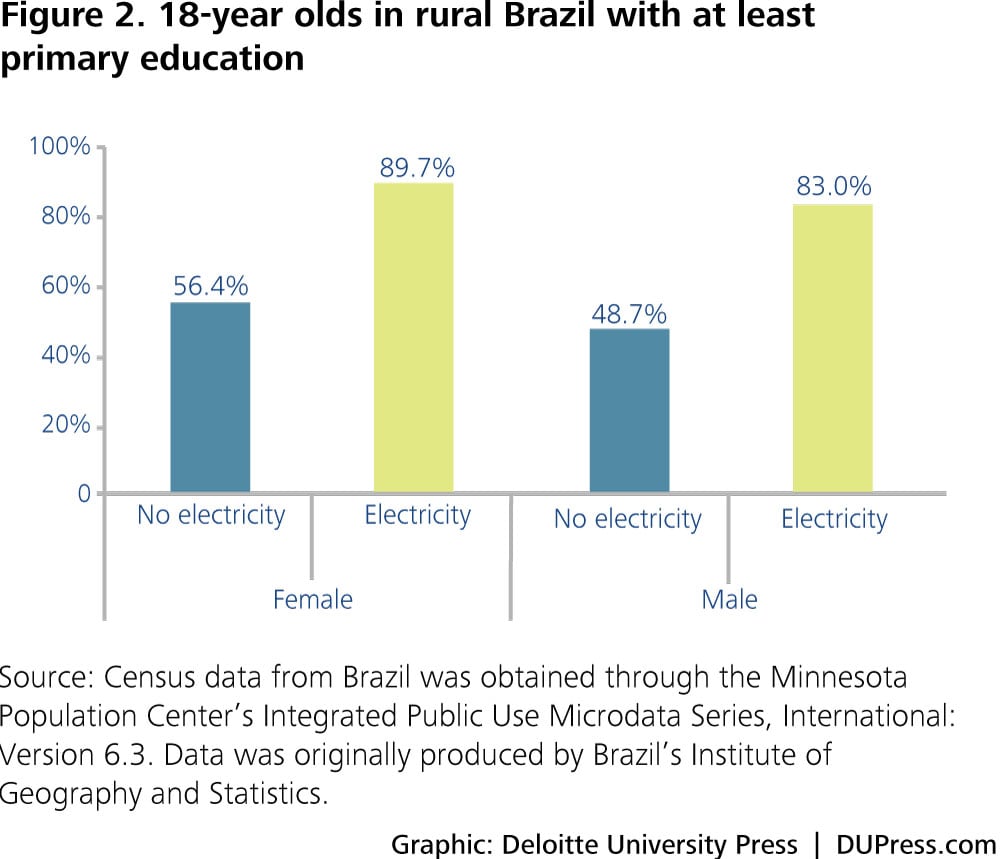 Next, we ask: How strongly is access to energy correlated with higher income for women? An initial look at the data reveals a striking gap in income for women with and without energy access. For example, the income of self-employed rural women with access to energy is over twice that of their counterparts without access to energy. For rural female wage/salary workers, access to energy is correlated with 59 percent higher wages. Similar trends hold for men. These gaps are even more pronounced in urban settings—148 percent to 322 percent higher incomes for those with electricity—as shown in figure 3.21
Next, we ask: How strongly is access to energy correlated with higher income for women? An initial look at the data reveals a striking gap in income for women with and without energy access. For example, the income of self-employed rural women with access to energy is over twice that of their counterparts without access to energy. For rural female wage/salary workers, access to energy is correlated with 59 percent higher wages. Similar trends hold for men. These gaps are even more pronounced in urban settings—148 percent to 322 percent higher incomes for those with electricity—as shown in figure 3.21
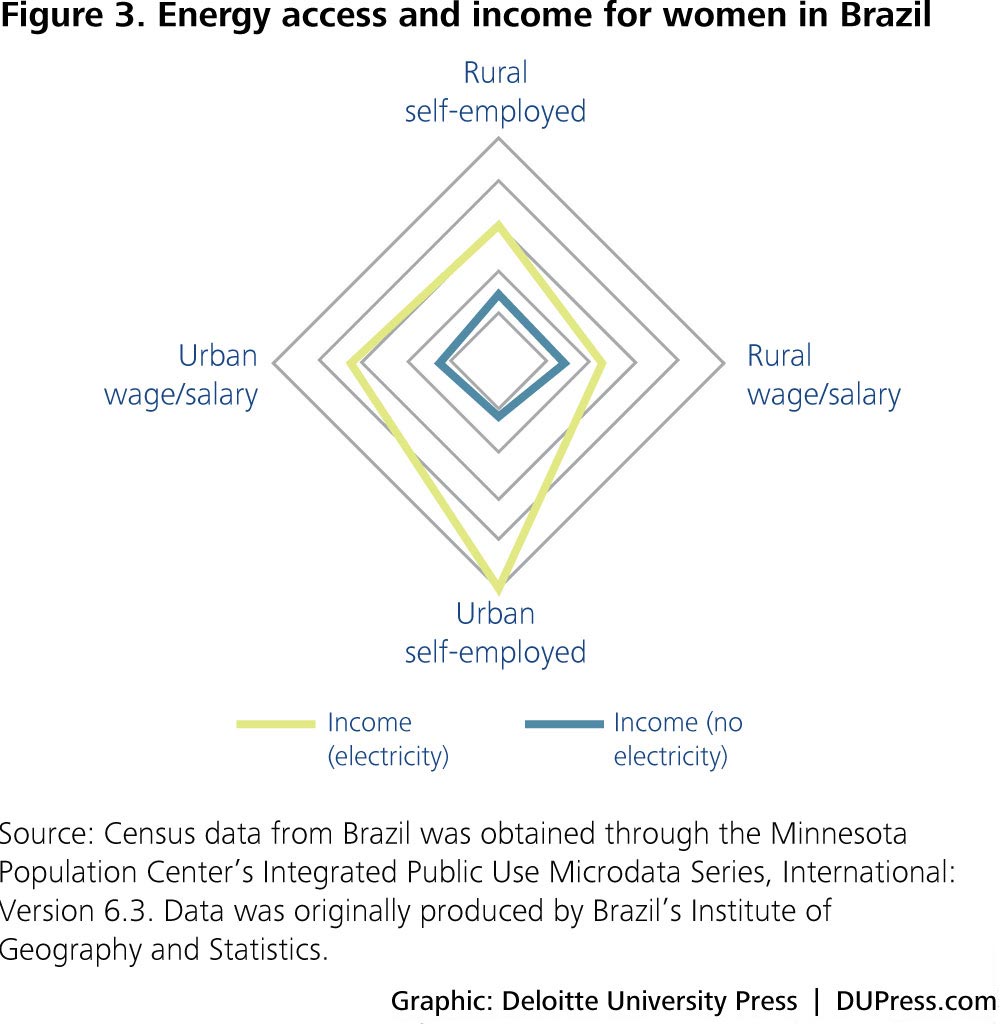 To determine that these differences in income levels are correlated with access to electricity, rather than with characteristics like level of education, industry, or occupation, we use a basic regression model. Again, we see that access to energy and a household appliance like a washer are positive predictors of income. Given the average rural incomes for men and women ($571 and $365, respectively), we see that having access to energy is correlated with a 10 percent higher income and having a washer with a 33 percent higher income—for both women and men.22 Importantly, the correlation of washer ownership with employment only exists for women.
To determine that these differences in income levels are correlated with access to electricity, rather than with characteristics like level of education, industry, or occupation, we use a basic regression model. Again, we see that access to energy and a household appliance like a washer are positive predictors of income. Given the average rural incomes for men and women ($571 and $365, respectively), we see that having access to energy is correlated with a 10 percent higher income and having a washer with a 33 percent higher income—for both women and men.22 Importantly, the correlation of washer ownership with employment only exists for women.
Energy as a catalyst for women’s economic empowerment
Our analysis draws a clear line from modern energy access to women’s economic participation. What are those factors, then, that translate energy into a reliable mechanism for women’s economic empowerment at the community level? From our experience implementing energy programs in developing countries and interviewing women on the ground, there can be many ways that energy access accelerates opportunities for women by moving them into more productive activities.
Reduced time burdens leading to higher-earning jobs and increased entrepreneurial opportunities
Women are often disproportionately responsible for household duties. This is particularly acute in rural settings, where women spend considerable time on tasks such as collecting firewood for basic cooking, heating, and lighting needs. Access to energy allows for more efficient products—from those as basic as a solar lantern to those as advanced as a washing machine. These products can reduce the time burdens of domestic responsibilities and create time for more productive, formal engagement in the local economy outside the home. Empirical studies that have examined the impact of electrification on female labor rates in developing country settings reinforce this hypothesis.
Ninety percent of the women in my country have the responsibility of housewife. To run a house requires resources, and energy is one of the most important requirements for that. Keeping the house warm, cooking, washing, and cleaning all require reliable sources of energy.23
—Roqia Motammhid, Afghanistan
A study executed by Taryn Dinkelman in South Africa during the mass rollout of electrification found that rural electrification raised female employment in electrified communities by 9.5 percent, likely because it released women from home production and enabled microenterprises, while having an indeterminate impact on male labor rates in the same communities.24 Another study by Grogan and Sadanand in Nicaragua illustrates that access to reliable electricity increases the propensity of rural women to work outside the home by approximately 23 percent due to more efficient home production in the form of lighting and modern cooking appliances, while it has no impact on male employment.25
From one side, there’s always the potential for new businesses and new jobs for women, whether it’s in particular in the energy sector or even in the supporting businesses around it.26
—Ruba A. Al-Zu’bi, Jordan
Microenterprises are recognized as key contributors to rural job creation and poverty alleviation, and electricity is often a necessary and important input.27 Women are able to dedicate time to wealth-enhancing activities—whether it be starting a small franchise, selling crafts, or working in the local store—and have reliable electricity for productivity-enhancing machinery. Microenterprises in particular require electricity to draw in customers, extend operating hours, improve working conditions, automate production, preserve products, and communicate beyond the local market.28
Improved baseline conditions leading to greater access to economic opportunities
There are a multitude of studies that demonstrate that improved access to electricity improves baseline living conditions for women. These studies show improvements to women’s health through cleaner indoor air; better nutrition and food safety due to improved refrigeration; and improved health knowledge through better access to mass media and more time to read.29 Interior and exterior lighting in rural settings often means improved security for women, enabling greater mobility to engage in productive activities under safe conditions. Anecdotal evidence also shows improved education for girls as a result of access to electricity, although most empirical studies do not show gender-differentiated impacts.30 Improving these baseline conditions facilitates the ease by which women can participate in the local economy: Healthy, safe, and informed individuals are more apt to be productive.
The single biggest challenge is security; the absence of affordable electricity opened the way for the ex-combatants to turn into armed robbers, unleashing mayhem on residents of areas not provided with electricity. Personally, my mother almost died because of the lack of affordable electricity.31
—Tenezee Miatta Emeka, Liberia
A niche role: Employing and utilizing women in the electricity value chain itself
There are opportunities to directly employ women in the electricity sector along the entire value chain, from installation and maintenance to distribution to billings and collections. Each aspect of the sector has a particular value proposition for women’s involvement. For example, collection rates on electricity bills, in both urban and rural settings, are extremely low across developing countries. The fields of microfinance and gender lens investing suggest that women are generally better credit risks for lending institutions and have better repayment rates than men.32 This makes them uniquely suited to be part of the collection system. Recent evidence from a pilot program in Ghazni, Afghanistan, shows that the local water utility was able to increase collections by 75 percent in the first month of a program that employed a brother and sister team to read utility meters. Among other factors, the woman was able to access meters at times when only women were home, which was culturally impermissible when the utility readers were men only.33
In my community, consumed electricity is metered according to the communal meter. . . . If even one household fails to pay the electricity bill, the whole community is disconnected. I assist my community in collecting electricity bills in the community to ensure timely and accurate payment of the bill that guarantees uninterrupted electricity supply to the village.34
—Marika Taniashvili, Georgia
As such, women’s particular roles in their families and communities, as well as their credit risk profile, make them potentially more effective than men for specific roles within the sector. In turn, this helps women to benefit from new employment opportunities and higher incomes, as well as creating positive implications for the community at large.
Energy programs with a gender lens
Maximizing the benefits accruing to women is as straightforward as applying a “gender lens” throughout, from the initial assessment to design and implementation, all the way through to monitoring and evaluation. In a sector that has normally not used a gender perspective, this is important. These gender-focused additions act as “X factors” that donor institutions and host governments can layer on to expand rural energy programs into economic empowerment programs, thereby magnifying the impact for local communities. We offer some considerations for each aspect of the process.
Invest in an initial assessment to understand the local environment for women
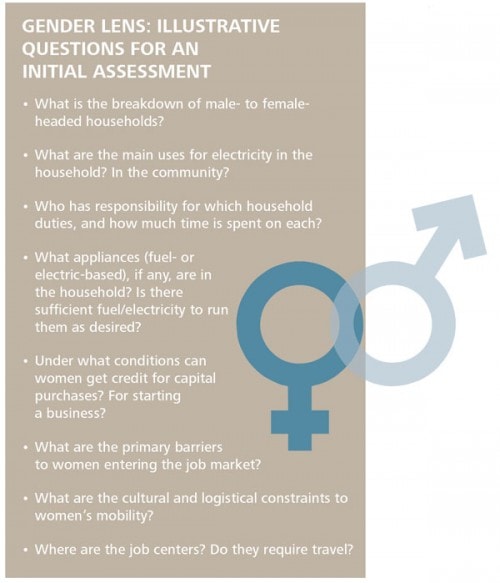 Before programs are designed, investigate the challenges of uptake in target communities, the demand factors for labor, and the potential areas for economic growth in the community, all with a gender-differentiated lens. Energy access and its potential impact on women is highly contextual to cultural sensitivities, religious beliefs, intra-household dynamics, ability to pay, and other economic and social factors. Furthermore, demand in local economies and drivers of labor will differ across communities, states, and countries. Understanding what kinds of jobs women want and how energy programs can be designed to foster them can enable an even more effective program design. Gendered assessments can illustrate the nuances of the local economy and, more specifically, how women interact with that economy. This in turn can lead program designers to better understand what type of rural electricity should be delivered, in what location, at what scale, and at what cost.
Before programs are designed, investigate the challenges of uptake in target communities, the demand factors for labor, and the potential areas for economic growth in the community, all with a gender-differentiated lens. Energy access and its potential impact on women is highly contextual to cultural sensitivities, religious beliefs, intra-household dynamics, ability to pay, and other economic and social factors. Furthermore, demand in local economies and drivers of labor will differ across communities, states, and countries. Understanding what kinds of jobs women want and how energy programs can be designed to foster them can enable an even more effective program design. Gendered assessments can illustrate the nuances of the local economy and, more specifically, how women interact with that economy. This in turn can lead program designers to better understand what type of rural electricity should be delivered, in what location, at what scale, and at what cost.
Lao PDR’s national electrification program: Why weren’t women connecting?
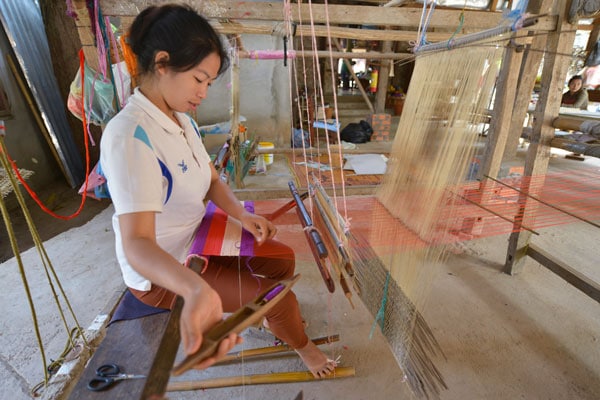
In Lao PDR’s rural electrification program, an assessment unearthed that grid connection uptake rates (that is the number of households that connect to the grid once it has been extended to a village) remained disproportionately low among female-headed households. In response, the program created a pro-poor, gender-sensitive subsidy targeted at female-headed households.
This was done through gender-appropriate materials that highlighted the benefits of electricity, gender-inclusive consultation and participation (for example, by scheduling meetings at times women were likely to be available), and female-friendly lending techniques. Without a targeted gendered assessment, this insight would not have been available. Connection rates went to well over 90 percent, even reaching 98 percent in several instances.35
Bring women into the design process
Once the initial assessment has been conducted, consult with women before rolling out an energy access program. This can provide insights into elements such as preferred methods for delivering electricity systems, how to design communications about new energy systems, and how to price the new systems, among other important factors. Including women in the planning stages is particularly important with electricity, which has traditionally been a male-dominated sector but is increasingly focused on the profiles of end users. Because of this, donors and host governments should be inclusive and creative, consulting with local women on a conscious, continuous, and concerted basis.
Governments could consider reserving dedicated spots for women as community representatives and within the electricity entities themselves, whether a rural electricity cooperative board of directors or a distribution billing and collections team. Intentionally seeking women’s opinions may lead to new insights and surprising innovations that can enhance a program’s effectiveness.
Set up enabling conditions for women’s economic participation
Piggyback energy access onto complementary programs that improve job prospects or enable entrepreneurship. Certain factors, such as access to capital, reliable Internet access, business associations or networks, training and education, and access to markets will increase the economic growth value of improved electricity access when sewn into rural energy programs.
Women’s particular challenges, such as fewer assets and the need to still fulfill household duties such as caring for children, must be considered. In order to capture the entrepreneurial gains, donors and host governments should incorporate one or two carefully selected factors into program design so that beneficiaries are presented with a multifaceted package. They may want to consider pilot programs in communities that already demonstrate some of these factors—for example, communities that offer strong women’s networks and female-friendly lending institutions—to increase the likelihood of early pilot successes.
See endnote 36
Utilize quantitatively rigorous monitoring and evaluation (M&E) to capture causality and impacts for women
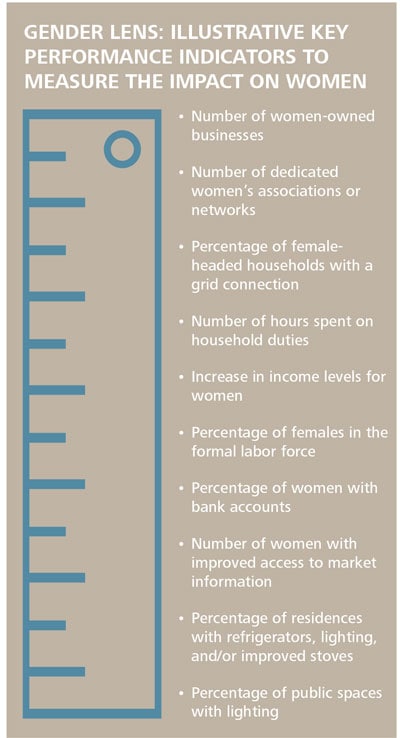 During and after energy access program implementation, use gender-differentiated indicators to measure the impact. Although there has been a significant investment in rural electrification, gender-disaggregated results are rarely captured, which impedes the ability to understand effective design factors and degree of impact by gender. Utilizing a targeted M&E framework of key performance indicators not only allows gender-differentiated linkages to be drawn, but also creates space for modifications to be made over time. Rigorous, regular, and objective measurement holds donors, governments, and implementing organizations alike accountable for their outcomes. Likewise, this accountability provides motivation to review and refine implementation strategies that are not working.
During and after energy access program implementation, use gender-differentiated indicators to measure the impact. Although there has been a significant investment in rural electrification, gender-disaggregated results are rarely captured, which impedes the ability to understand effective design factors and degree of impact by gender. Utilizing a targeted M&E framework of key performance indicators not only allows gender-differentiated linkages to be drawn, but also creates space for modifications to be made over time. Rigorous, regular, and objective measurement holds donors, governments, and implementing organizations alike accountable for their outcomes. Likewise, this accountability provides motivation to review and refine implementation strategies that are not working.
Conclusion
Given the global emphasis on energy access, many of these programs are likely to be rolled out in the near future, with millions of dollars in funding being committed. This represents a rare opportunity to intentionally shape programming so that it is not only electrifying communities, but empowering women within those communities to be more efficient in their household duties, make further gains in education, enter the workforce, and start businesses. Not only will this provide opportunities for those often disenfranchised, but it will also help accelerate economic growth in developing countries and lay the foundation for an emerging middle class. If done thoughtfully, spurring access to energy could spur 50 percent of a labor force to be more productive and more engaged. A gender lens approach to energy access programs can be beneficial all the way around—for women, for local communities, and for emerging nations.
Appendix
Table 1. Employment profit analysis results
Prob(Y = 1) = Φ(α + β1x1 + β2x2 +…+ ε), where Y = employed
Table 2. Income regression analysis results
yi = α + β1xi1 + β2xi2 +…+ εi, where y = income
© 2021. See Terms of Use for more information.

